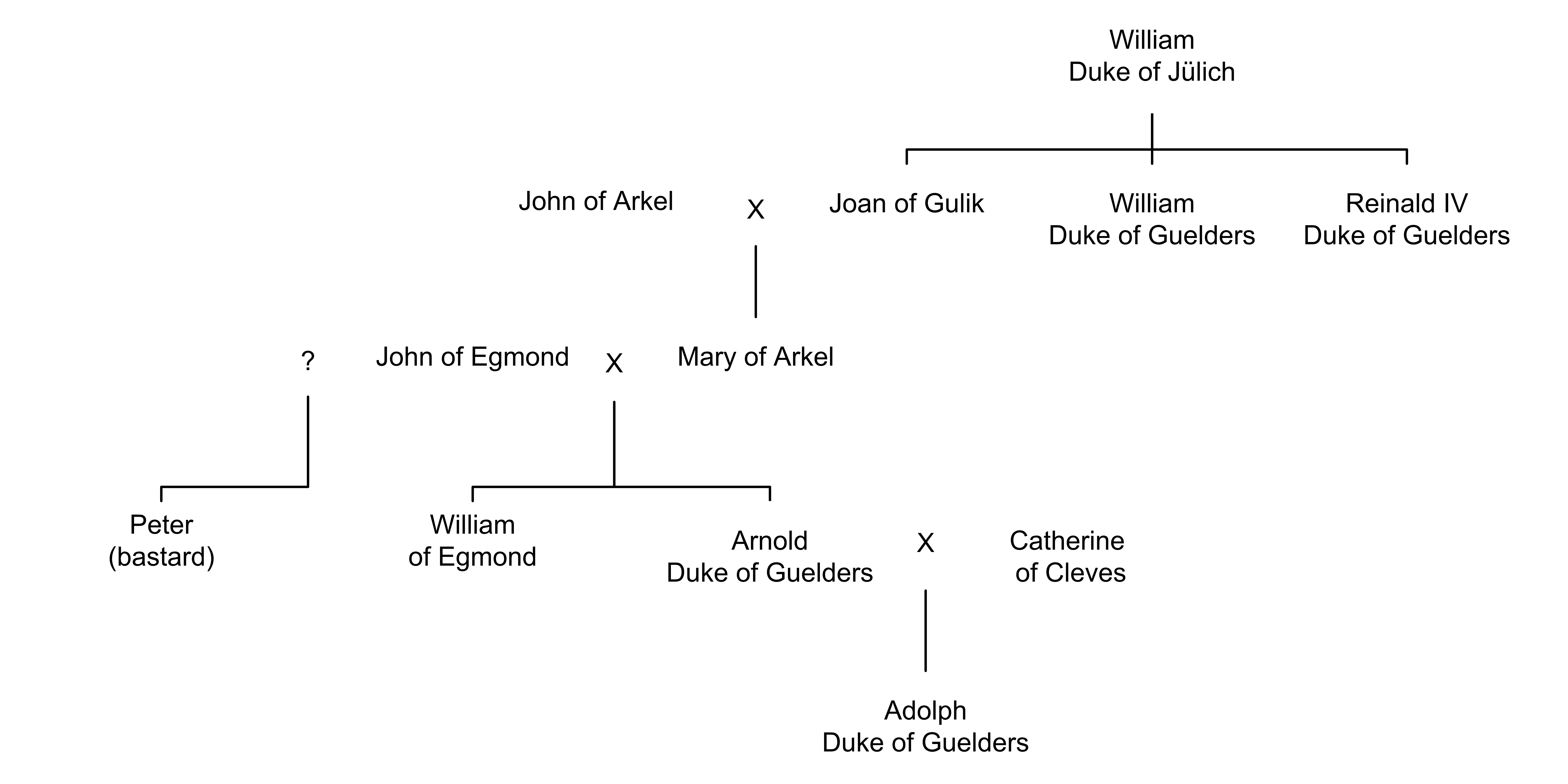It’s all in the family
In fifteenth century Guelders (grosso modo modern day Gelderland), the brothers of duke Arnold preyed on each other’s property – former princely possessions given to them – and took different sides in the civil war between the duke and his son.
A new family on the throne
In July 1423, the Estates of Guelders accepted Arnold – oldest son of John, lord of Egmond – as the new duke of Guelders. Arnold was a relative of the late duke Reinald IV, who died a month earlier. Although Arnold and Reinald were related, the power base of Arnold’s family traditionally lay in Holland, rather than Guelders. As a result, Arnold was transferred to a new social and political environment. In Holland, his father was one of the foremost nobles, lord of Egmond, till 1416. Tied to the conflict between the Hooks and the Cods (Hoeken en Cabeljauwen), the count of Holland had taken the property of the lord of Egmond. The count had promised him compensation in the form of an annual payment, but the loss of the extended tracts of land, judicial rights (the lordship of Egmond), castles et cetera, eroded the social, military and financial status of John of Egmond. After his son Arnold ascended the Guelders’ throne, he transferred princely domains to his father and brothers, likely to counter the erosion of his family’s status. This made his relatives a (local) factor to be reckoned with, in turn strengthening the ducal power base. As it turned out, this proved to be rather problematic.

Simplified family tree of Arnold of Guelders.
A new base of operations
The new power base was possibly formed around the dowry of Mary of Arkel. When she married John of Egmond, duke Reinald of Guelders had promised her a considerable sum of money, which was secured on local property. Whether John and Mary had other possessions in this region is unknown. In 1438, it is clear John of Egmond had acquired extensive rights in Guelders, probably gifts from his son. The (premature) division of the inheritance of John, which Arnold and William drafted in 1438, sheds light on the Egmond property in Guelders and elsewhere. In general, Arnold only claimed the inheritance of his mother, Mary of Arkel. Unsurprisingly, as his claim to the Guelders throne was based on his Arkel lineage. All the rights and income John of Egmond held in Guelders, would be inherited by William. The future inheritance consisted of financial resources in the Betuwe region, the toll of IJsseloord near Arnhem, the castles of Nergenna and Hattem (respectively near Goch and Zwolle), and the opportunity to buy the lordship of Born (near Sittard). Most of this property was mortgaged. The duke had attracted loans, of promised payments, by using the property as a surety for future payment. As long as the duke didn’t pay, the creditor could administer these rights and castles. For example, William could use the castle of Hattem as a surety for the sum of 5.000 guilders, which the duke had promised to pay him.

The town of Hattem, with the castle at the bottom. Part of the facsimile (1916-1923), after the original by Jacob van Deventer (ca. 1560). Gelders Archief Arnhem, 1551. Topografisch-historische Atlas Gelderland, inv.nr. 1884.
A conflict between two brothers
The ownership over the castle of Hattem was a particularly problematic issue. John of Egmond had managed this castle up to his death in 1451. After his death, and probably before, his bastard son Peter had acted as a steward of the castle. According to him, he had transferred the castle to duchess Catherine shortly after the death of his father. However, at that time, the duchess supported her son Adolph in his war against her husband, duke Arnold. The duke was in turn supported by his brother William. By transferring the castle to Catherine, Peter had undermined the political and military position of his brother the duke, and the financial claims of his brother William. To compensate for the financial loss, William had taken some of Peter’s property. Which property is unclear, although some domanial rights in the vicinity of Heerde (10 km from Hattem) come to mind. In 1449, duke Arnold had assigned these rights to his brother, worth 1.200 Rhenish guilders, as compensation for a loan. In one go, Arnold also gave his brother permission to buy another complex of domanial rights, which Peter never used. Arnold explicitly stated, that he wanted to improve the social status of his bastard brother ("soe hebben wij Peter onser bastertbroider vurs. megtig gemaicht ind gegont mechtich maicher"). How the bastard had accumulated the fortune of 1.200 guilders prior to 1449, why he loaned this to his ducal brother, or if this even really happened, is unclear. Most likely, both transactions were connected to Arnold’s wish to support his brother. As a rule, bastards could not inherit their parent’s goods, creating a necessity to provide for them in other ways. Probably, John of Egmond was involved in transferring the funds to Peter, either as primary actor or as instigator of a gift by his son, the duke.

Eighteenth century depictions of Arnold (left) and Adolph (right), dukes of Guelders. Jean-François Dreux du Radier, L'Europe illustrée, t. I, (Paris, 1755).
While Peter supported his sister-in-law and her son against the duke, William was a staunch supporter of his brother, the duke. At the end of Arnolds reign and life, he was abandoned by most of his subjects. His son Adolph had locked him up between 1465-1470, and after being released, Arnold’s authority was accepted only in parts of Guelders. Among his few supporters were William and his sons; John and Frederick. Their help was not for free. In 1471, duke Arnold enlarged the rights attached to the lordship of Bahr, which William held as a result of marriage. In his letter, Arnold stated that part of the river IJssel, including fishing rights, were to be adjoined to the lordship. Notably, he stated that this had always been the case previously, that there were even letters to confirm this, but that his brother couldn’t find these letters ("die onse lieve broeder nyet vynden off an komen en kan"). Although there was no proof, Arnold explicitly stated that he believed his brother ("mercken ende bevinden dat id wair is"). Moreover, since his brother had supported him during his period of incarceration, he also enlarged the lordship of Bahr with the nearby district of Lathum. Almost a year later, Arnold also transferred the lordship of Buren to Frederick, son of his brother William. Likely a reward for his support as well.
Despite the aforementioned ducal donations, the power of the Egmond family in Guelders was not long-lived. The dukes of Guelders, from the line of the lords of Egmond, became extinct with the death of Arnold’s grandson Charles, in 1538. The descendants of Frederick held on to the lordship Buren till 1551, when William of Orange obtained it via marriage. The lordship of Bahr, held by the senior branch of the Egmond family, was sold in 1562.
© Jaap Ligthart and Leiden Medievalists Blog, 2018. Unauthorised use and/or duplication of this material without express and written permission from this site’s author and/or owner is strictly prohibited. Excerpts and links may be used, provided that full and clear credit is given to Jaap Ligthart and Leiden Medievalists Blog with appropriate and specific direction to the original content.


